A community-based energy bank for electricity generation using renewable fuels: A case of rural community in Tak Province, Thailand
DOI:
https://doi.org/10.14456/rcmrj.2017.213798Keywords:
renewable energy, sustainability, energy bankAbstract
By 2040 the desire for using energy of the world’s people will increase by 30% of the present. (Siamintelligence, 2011). Hence, countries move to explore and promote alternative energy, including renewable options to pamper ever-rising demand for energy. Yet leaders of renewable power developers remain mostly in developed countries as Table 1 thanks mainly to resource endowment and development capacity. Only China and India from developing country appear on the list, indicating that there might be some challenges that need to be overcome in promoting renewable energy.
The same challenges may exist in Thailand. Being an oil dependent country, Thailand imports about 80% of the energy supply (Department of Alternative Energy Development and Efficiency, n.d.), fossil fuels specifically, thus making the Thai economy vulnerable to the price and supply volatility of the world oil markets (BP, 2012). Also, being a small importing country, Thailand has had gambled its economic development and social betterment on oil imports. Though Thailand has not been able to disassociate itself from fossil fuels, energy policies have been focusing on both supply and demand sides to reduce this dependency.
Downloads
References
Carlisle, N., Elling, J. and Penney, T. 2008. A Renewable Energy Community: Key Elements. (Prepared under Task No. 2940.0007). A national laboratory of the U.S. Department of Energy. Office of Energy Efficiency & Renewable Energy.
Chanovit, W. 2014. Cost Benefit Analysis of Solar photovoltaic rooftop project (Residential type) in different radiation area of Thailand. (online). Retrieved from: http://econ.nida.ac.th/index.php?option=com_content&view=article&id=3034%3A----mbe2557&catid=129%3Astudent-independent-study&Itemid=207&lang=th (December 16, 2016)
Chunam, P. n.d.. How to apply sufficient economy philosophy in community level. In Hongpakdee, N. (editor). Sufficient economy philosophy and Thai society. pp. 154-168. Bangkok: Studies Center of Sufficiency Economy NIDA.
Department of Alternative Energy Development and Efficiency. n.d.. 15 years energy development plan 2008-2023. (online). Retrieved from: http://www.eppo.go.th /ccep/download/REDP_15_yrs.pdf (December 15, 2016)
Department of Alternative Energy Development and Efficiency. 2015. Alternative Energy Development Plan : AEDP2015. (online). Retrieved from: http://www.eppo.go.th /images/POLICY/PDF/AEDP2015.pdf (December 15, 2016)
Department of Pollution Control. 2008. The handbook of reduction, segregation, and utilize garbages for environment protection volunteers. Bangkok: Rungsilp publishing.
Dyson, C. and Jennifer E. Canseco, 2008. Best Practices in Community Energy-Efficiency and Renewable Energy Partnership Programs. pp.74-84. Proceedings of 2008 ACEEE Summer Study on Energy Efficiency in Building.
Heruela, C. 2006. Renewable Energy for Rural Development in the Mekong Region. International Journal of Renewable Energy, 1(2), 1-5.
Johansen, J.P. and Royrvik, J. 2014. Organizing synergies in integrated energy systems. Energy Procedia 58. pp.24 – 29. Renewable Energy Research Conference, RERC 2014.
Kriyapak, S. 2009. Appropriate community energy management. Thesis M.Sc, NIDA.
Klomjit, K. and Kaweeyarn, K. 2011. Appropriate renewable energy for Thailand under global warming crisis. Engineering Press, 76(24), 23-32.
Maneeprauk, S. 2001. Community economy ideas. In The production committee of economic history and ideas (editor). Economic history and ideas document unit 15. Nonthaburi: Sukhothai Thammathirat Open University.
Natsupa, C. 2005. Ideas of community economy in different society. 2nd ed. Bangkok: Saang San.
Noratus, T. 2007. The driven philosophy of Sufficiency Economy in the industrial sector with TIS. 9999. (Online). Retrieved from: https://www.gotoknow.org/posts/573126 (December 16, 2016)
Office of the National Economic and Social Development Board. 2012. The Eleventh National Economic and Social Development Plan (2012 - 2016). (online). Retrieved from: http://www.nesdb.go.th/download/article/article_20160323112431.pdf (September 5, 2016)
Phanhingong, K. n.d. Exploring knowledge for Thailand reforming: Land Bank. Nonthaburi: Office of reforming.
Phoochinda, W. 2009. How to apply sufficient economy philosophy to community energy management. Environmental management, 5(2), 118-136.
Phoochinda. 2010. Lessons learned from successful community energy management by complying to sufficient economy philosophy. Environmental management, 6(2), 113-131.
Phoochinda. 2015. Initial assessment of the social return on investment of electricity generation using biomass : a case study of gasifier plant. Journal of Environmental Management, 11(2), 90-105.
Siamintelligence. 2011. ExxonMobil energy industry forecasts 2040 the world requires 30% more energy. (online). Retrieved from: http://www.siamintelligence.com/exxonmobil-
energy-outlook-2040/Worldalert: renewable energy boosted. (September 12, 2011)
Sirikoon, S. 2010. Micro-scale biomass power plant development and community issues. Documents for the Micro-scale biomass power plant promptness and potentiality for community seminar. Bangkok.
Sriwichailampan, T. 2012. Community business development. Chiangmai: Faculty of Economics, Chiang Mai University.
Upretia, B.U. and Horst, D.V. 2004. National renewable energy policy and local opposition in the UK : the failed development of a biomass electricity plant. Biomass and Bioenergy, 26(1), 61-69.
Watjanatepin, N. et.al. 2008. Evaluation of Electrical Service Acceleration Project By Solar Home System : SHS. Paper presented at the 4th Conference On Energy Network of Thailand (E-NETT), 14-16 MAY 2008. (Online). Retrieved from:
http://eng.rmutsb.ac.th/events/admin2/Redearch_papers/Evaluation%20of%20Electrical%20Service%0Acceleration%20Project%20By%20Solar%20Home%20System.pdf (December 16, 2016)
What is Tree Bank. n.d. (online). Retrieved from: http://www.treebankthai.com/images/intro_ 1324056483/%C3%D9%E9%A8%D1%A1%20%B8%B5%C1.pdf (September 5, 2016)
Downloads
Published
How to Cite
Issue
Section
License
1. Articles, information, content, images, etc published in the “Community and Social Development Journal” are copyrighted by the Community and Social Development Journal, Chiang Mai Rajabhat University. In order to properly distribute the articles through print and electronic media, the authors still hold the copyright for the published articles under the Creative Commons Attribution (CC BY) license, which allows the re-distribution of the articles in other sources. References must be made to the articles in the journal. The authors are responsible for requesting permission to reproduce copyrighted content from other sources.
2. The content of the articles appearing in the journal is the direct responsibility of the article authors. The editorial board of the journal does not necessarily agree with or share any responsibility.














